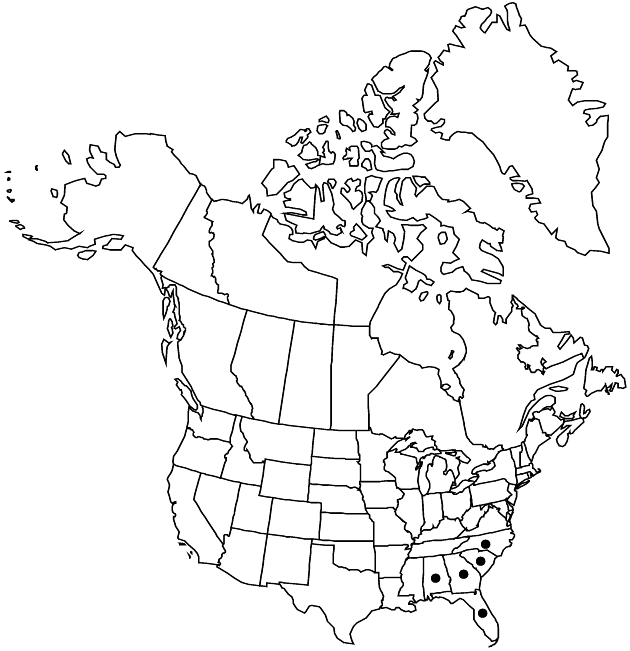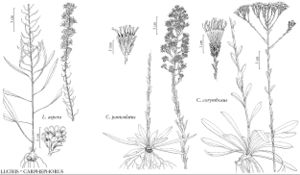Difference between revisions of "Carphephorus paniculatus"
Rhodora 70: 483. 1968.
Common names: Hairy chaffhead
IllustratedEndemic
Basionym: Chrysocoma paniculata J. F. Gmelin Syst. Nat. 2: 1204. 1792
Synonyms: Liatris paniculata (J. F. Gmelin) Michaux Trilisa paniculata (J. F. Gmelin) Cassini
FNA>Volume Importer |
imported>Volume Importer |
||
| (5 intermediate revisions by 2 users not shown) | |||
| Line 8: | Line 8: | ||
}} | }} | ||
|common_names=Hairy chaffhead | |common_names=Hairy chaffhead | ||
| − | |basionyms={{Treatment/ID/ | + | |special_status={{Treatment/ID/Special_status |
| + | |code=F | ||
| + | |label=Illustrated | ||
| + | }}{{Treatment/ID/Special_status | ||
| + | |code=E | ||
| + | |label=Endemic | ||
| + | }} | ||
| + | |basionyms={{Treatment/ID/Basionym | ||
|name=Chrysocoma paniculata | |name=Chrysocoma paniculata | ||
|authority=J. F. Gmelin | |authority=J. F. Gmelin | ||
| + | |rank=species | ||
| + | |publication_title=Syst. Nat. | ||
| + | |publication_place=2: 1204. 1792 | ||
}} | }} | ||
|synonyms={{Treatment/ID/Synonym | |synonyms={{Treatment/ID/Synonym | ||
|name=Liatris paniculata | |name=Liatris paniculata | ||
|authority=(J. F. Gmelin) Michaux | |authority=(J. F. Gmelin) Michaux | ||
| + | |rank=species | ||
}} {{Treatment/ID/Synonym | }} {{Treatment/ID/Synonym | ||
|name=Trilisa paniculata | |name=Trilisa paniculata | ||
|authority=(J. F. Gmelin) Cassini | |authority=(J. F. Gmelin) Cassini | ||
| + | |rank=species | ||
}} | }} | ||
|hierarchy=Asteraceae;Asteraceae tribe Eupatorieae;Carphephorus;Carphephorus paniculatus | |hierarchy=Asteraceae;Asteraceae tribe Eupatorieae;Carphephorus;Carphephorus paniculatus | ||
| Line 41: | Line 53: | ||
-->{{#Taxon: | -->{{#Taxon: | ||
name=Carphephorus paniculatus | name=Carphephorus paniculatus | ||
| − | |||
|authority=(J. F. Gmelin) H. J.-C. Hebert | |authority=(J. F. Gmelin) H. J.-C. Hebert | ||
|rank=species | |rank=species | ||
| Line 55: | Line 66: | ||
|publication title=Rhodora | |publication title=Rhodora | ||
|publication year=1968 | |publication year=1968 | ||
| − | |special status= | + | |special status=Illustrated;Endemic |
| − | |source xml=https:// | + | |source xml=https://bitbucket.org/aafc-mbb/fna-data-curation/src/2e0870ddd59836b60bcf96646a41e87ea5a5943a/coarse_grained_fna_xml/V19-20-21/V21_1364.xml |
|tribe=Asteraceae tribe Eupatorieae | |tribe=Asteraceae tribe Eupatorieae | ||
|genus=Carphephorus | |genus=Carphephorus | ||
Latest revision as of 20:09, 5 November 2020
Plants (30–)50–120(–180) cm. Stems densely and coarsely villoso-hirsute, eglandular. Leaves: basal and proximal cauline oblanceolate to narrowly elliptic, mostly 5–35 cm, margins plane; cauline much reduced, faces not gland-dotted. Heads in thyrsiform (often ± columnar) arrays. Peduncles stipitate-glandular (each with a subtending bract). Involucres (3.5–)4–6 mm. Phyllaries 5–12 in 1–2(–3) series, oblanceolate, gland-dotted or stipitate-glandular (sometimes with eglandular, biseriate hairs as well), apices acute to obtuse. Receptacles epaleate or partially paleate (paleae 1–2). Corollas glandular, lobes 1–1.5 mm. Cypselae eglandular; pappus bristles in ± 1 series. 2n = 20.
Phenology: Flowering (Aug–)Sep–Dec(–Jan).
Habitat: Moist or wet, low ground, wet prairies or savannas, swamp margins, pine, pine-palmetto, and palmetto flats
Elevation: 0–50 m
Distribution

Ala., Fla., Ga., N.C., S.C.
Discussion
Selected References
None.
Lower Taxa
None.
